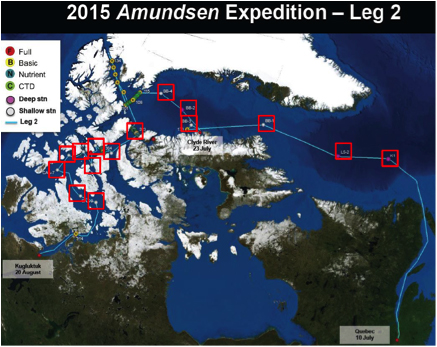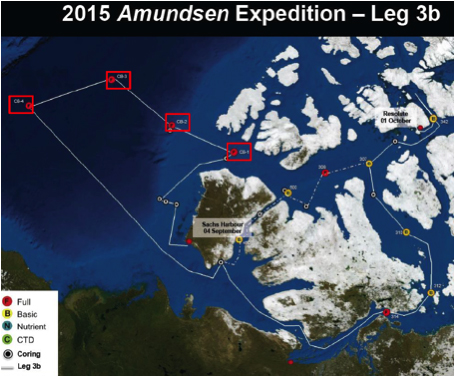Forthcoming cruise departure of the Canadian Arctic GEOTRACES Programme
The Canadian Arctic GEOTRACES Programme “A biogeochemical and tracer study of a rapidly changing Arctic Ocean” consists of 2 cruises on board the CCGS Amundsen, spanning between July 10 and October 1st, 2015. On board of the cruise there will be ~45 scientists from mainly Canada, but also from other countries. The first cruise (Leg 2) will depart from Quebec City (Quebec, Canada) on July 10 to undertake an integrated oceanographic transect in the Labrador Sea, Baffin Bay and the Canadian Arctic Archipelago. This first cruise will return to port on August 21, in Kugluktuk (Nunavut, Canada). The second cruise (Leg 3b) will explore mainly the Beaufort Sea, departing from Sachs Harbour (Northwest Territories, Canada) on September 4th, 2015 and returning to port in Resolute (Nunavut, Canada).
The Arctic marine system is undergoing rapid change as a result of climate-driven alterations in sea ice cover and surface ocean circulation, which in turn can strongly influence biological productivity, air-sea exchange of climate-active gases (e.g. CO2) and the distribution of contaminants (e.g. mercury, lead). Against this background of climate-driven changes, there will likely be significant expansions of commercial fishing, shipping and exploitation of fossil fuel and mineral resources, particularly in the Canadian Arctic Archipelago (CAA). At present, our ability to fully understand the impacts of these changes and predict their future trajectory is limited by a poor understanding of the interacting chemical, physical and biological processes which shape the functional characteristics and resiliency of Arctic waters. To bridge this critical knowledge gap, we will participate in an international, pan-Arctic field study (Arctic-GEOTRACES) measuring a suite of chemical tracers that provide information on key biological, physical and chemical processes in the Arctic Ocean and CAA. We will map the distribution of these tracers across important hydrographic provinces in the Arctic, following main flow paths of Pacific waters through the CAA to study the biological, physical and chemical transformations which occur as waters move towards the Atlantic Ocean. We will couple our chemical measurements with detailed surveys of water mass structure and circulation, and the results will be incorporated into computer models predicting Arctic Ocean responses to climate change and other human-related disturbances. We will also conduct ship-board manipulation experiments to directly assess the potential influence of ocean acidification (caused by increasing surface ocean CO2 levels) and changes in trace metal concentrations on productivity and species abundances at the base of the Arctic marine food web. Results from our work will provide foundational information critical for sustainable development in the Arctic.
 |
 |
Figures: Canadian Arctic GEOTRACES Programme cruise tracks. To view the figures larger click on the following links: leg 2, leg 3.
The main scientific objectives of this programme are to:
(1) develop novel water & circulation tracers to monitor future circulation changes in the CAA,
(2) assess the effect of ocean acidification on metal speciation, bioavailability and toxicity
(3) documente the effect of TEs on primary and secondary production & trace gas emissions in the CAA, and
(4) integrate physical, biological and chemical parameters into a numerical model (NEMO+PISCES, Bopp et al., 2005) to predict changes in circulation & productivity in the CAA, their consequences in the N. Atlantic, and globally
A cruise blog is available at: blogs.ubc.ca/geotraces2015
Chief Scientists for Leg 2: Roger Francois (rfrancois@eos.ubc.ca) and Philippe Tortell (ptortell@eos.ubc.ca) (UBC, Vancouver, Canada).
Chief Scientists for Leg 3b: Roger Francois (rfrancois@eos.ubc.ca) and Kristin Orians (korians@eos.ubc.ca) (UBC, Vancouver, Canada).
